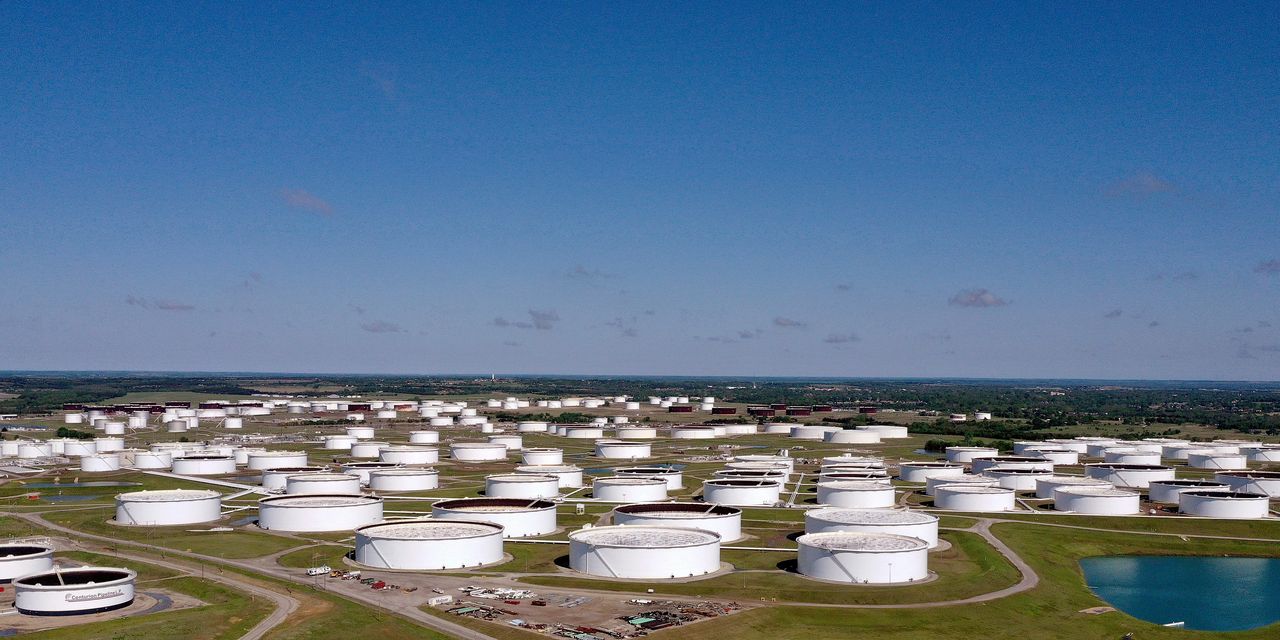Oil futures finished higher on Wednesday, finding support after data showed China’s crude imports rose in May, despite a decline in imports overall.
Data from the Energy Information Administration showing a smaller-than-expected weekly decline in U.S. crude inventories also helped to support a rise in oil prices, though the data also revealed gains in petroleum-product inventories.
Price action
-
West Texas Intermediate crude for July delivery
CL00,
+1.06% CL.1,
+1.06% CLN23,
+1.06%
rose 79 cents, or 1.1%, to settle at $72.53 a barrel on the New York Mercantile Exchange. -
August Brent crude
BRN00,
-0.13% BRNQ23,
-0.13% ,
the global benchmark, added 66 cents, or 0.9%, at $76.95 a barrel on ICE Futures Europe. -
Back on Nymex, July gasoline
RBN23,
+3.05%
rose 3% to $2.64 a gallon, while July heating oil
HON23,
+1.56%
climbed 1.4% at $2.40 a gallon. -
July natural gas
NGN23,
+3.01%
rose 3% to $2.33 per million British thermal units.
Supply data
U.S. supply data released Wednesday was overall bullish as U.S. refiners had to “really kick up activity, and they hit the highest level with activity since August of 2019,” said Phil Flynn, senior market analyst at The Price Futures Group. “That shows that demand for products is exceedingly strong and better than people were saying.” The Energy Information Administration said Wednesday that U.S. refineries operated at 95.8% of their operable capacity last week.
U.S. commercial crude inventories edged down by 500,000 barrels for the week ended June 2, the EIA reported.
That compared to an average decline of 1 million barrels forecast by analysts polled by S&P Global Commodity Insights. The American Petroleum Institute late Tuesday reported a 1.7 million barrel weekly decline in U.S. crude inventories, according to a source citing the data.
The EIA report showed weekly inventory increases of 2.7 million barrels for gasoline and 5.1 million barrels for distillates. Analysts had forecast weekly climbs of 750,000 barrels for gasoline and 1 million barrels for distillates.
Crude stocks at the Cushing, Okla., Nymex delivery hub rose by 1.7 million barrels for the week, the EIA said, while oil stocks in the Strategic Petroleum Reserve declined by 1.9 million barrels.
Total U.S. petroleum production, meanwhile, climbed by 200,000 barrels a day for the week ended June 2 to 12.4 million barrels a day, EIA data showed.
A separate monthly report from the EIA released Tuesday revealed forecasts for record-high U.S. oil output for this year and next and said global supplies are expected to tighten following an OPEC+ decision to extend production cuts through 2024. The government agency also raised its and and retail gasoline price forecasts, but lowered its outlook for natural-gas prices.
Other market drivers
Prices for oil had already been trading higher when the EIA supply data were released.
Those gains came as traders assessed the latest import and export data from China, focusing on a month-on-month rise in crude-oil imports.
China exports dropped 7.5% from a year ago in May, cooling substantially from the 8.5% growth seen in April, data from the General Administration of Customs showed Wednesday. A survey of economists by The Wall Street Journal produced a median forecast for a 1% decline. Imports declined 4.5% from a year earlier, compared with a 7.9% decline in April. Economists, on average, had expected imports to have fallen 8.1%.
But the data showed China’s crude oil imports recovered to 51.44 million tons, or around 12.16 million barrels a day, up 17% month-on-month and 12% year-over-year, in May, noted Warren Patterson and Ewa Manthey, commodity strategists at ING, in a note.
“Demand slowdown from China has been a major concern for the crude oil market recently, and a recovery in oil imports is likely to provide some comfort to the oil market,” they wrote.
Still, for now, Manish Raj, managing director at Velandera Energy Partners, said “smart money is staying on the sidelines until more convincing data emerges on either demand picking up, or supply actually going down.”
“So far, both stories have been elusive, with no sign of demand pickup, or of supply actually going down,” he told MarketWatch.
Read the full article here













